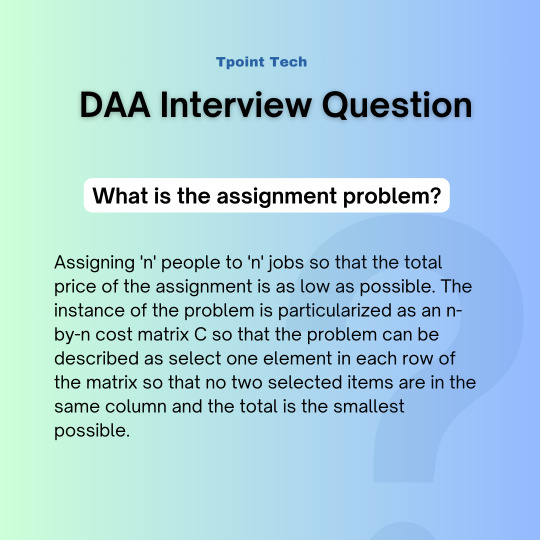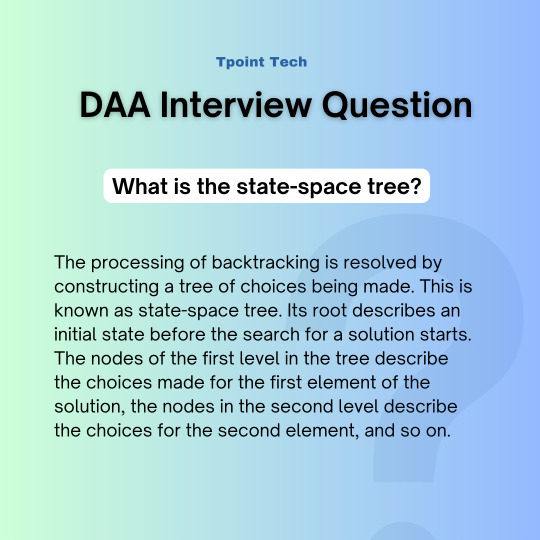#quicksort
Explore tagged Tumblr posts
Text
Exploring Quantum Leap Sort: A Conceptual Dive into Probabilistic Sorting Created Using AI
In the vast realm of sorting algorithms, where QuickSort, MergeSort, and HeapSort reign supreme, introducing a completely new approach is no small feat. Today, we’ll delve into a purely theoretical concept—Quantum Leap Sort—an imaginative algorithm created using AI that draws inspiration from quantum mechanics and probabilistic computing. While not practical for real-world use, this novel…
#AI#algorithm#amazon#chatgpt#coding#computer science#css#data-structures#DSA#engineering#google#heapsort#insertionsort#javascript#mergesort#new#programming#python#quicksort#radixsort#sorting#tech#tesla#trending#wipro
2 notes
·
View notes
Text

🚀 Cracking coding interviews starts with mastering concepts! 💡
Ex: Divide and Conquer: This technique breaks down complex problems, solves smaller subproblems, and merges them for efficient solutions.
Quick Sort is a great example and is perfect for handling large datasets. ⚙️
Want to boost your algorithmic skills? This is a game-changer! Keep learning, solving, and growing! 🔥
👉 Check out all the interview questions here: https://bit.ly/3RqSFtC✨💻
0 notes
Text
Grokking Algorithms #4: Divide and Conquer
This post covers Chapter 4 from Grokking Algorithms, which introduces the Divide and Conquer approach as a lead-in to the Quicksort algorithm. Divide and Conquer When I was ten years old, I participated in a weeklong camp program as part of my fifth grade class. The participants were divided into groups, with each group assigned a guide. One night, our guide told a fable about a village in…

View On WordPress
0 notes
Text
1)a) Quiky sort

#more jovial than quicksort#yes it was an attempt at an exam answer (not omitting anything)#candidate forgot to mention the time complexity of quiky sort to get full marks!#plz lmk if you figure it out
0 notes
Text
i have a test in 10 minutes and im thinking about bakudeku. cant do rthis rn
#txt#how do you write a quicksort algorithm out of scratch please help#dont actually help im shutting my phone down
1 note
·
View note
Note
has there been a single poll so far where the first option didn't win. what's up with that
It isn't universal, but the fact that the vast majority of competitors on top are winning means that my seeding wasn't totally awful.
In most cases, the competitor on the bottom will have a lower seed, which essentially means that, when I was manually quicksorting them*, I thought they would perform worse.
*I used a quicksort algorithm to create a list of competitors ordered by seed by hand after about 4 hours of sorting. If the seeding becomes egregiously bad as we progress towards the finale, that is because, including things like bathroom breaks and eating lunch, I spent an average time of 7.5 seconds per comparison**
**I didn't actually count the total number of comparisons, but a quicksort algorithm supposedly makes an average of 1.39n × log(n) comparisons to sort a list of n size
95 notes
·
View notes
Text
Easier to sort than looking up every title individually.
i DESPERATELY want an elo-type ranker that will let me sort my tbr by the books i'm most interested in reading, PREFERABLY a calibre plugin that will let me choose by clicking on covers because that's the place that has most of my books with covers. i tried just using a site that let me copy/paste a list but without the covers i had to look up every title to figure out what the fuck i was choosing between :(
#Also if you have like. Library-duty shelving#and can just shelve the ones already sorta-sorted#i tend to use MergeSort for physical books#Quicksort is faster if I’m dragging digital icons around tho#Books
130 notes
·
View notes
Text
learned about a new sorting algorithm you can use to inflict psychological damage on anyone who reads your code
it's like quicksort, but the recursive steps are replaced with a merge sort, but the recursive steps in the merge sort are replaced with quicksort again, and the layers keep alternating (don't worry. it's still O(nlogn), deterministic, and O(logn) space complexity)
if you're not worried about time you can inflict even more psychological damage by implementing as many recursive sorting algorithms as you can think of and making it pick randomly between them for each recursive call
24 notes
·
View notes
Text

New Jeans wearing Fintech Blue, Powerplant Green, Sieve Umber, Blaze Fuschia, and Quicksort Purple
41 notes
·
View notes
Text
JÁ NEVÍM, JAK FUNGUJE MERGESORT, HEAPSORT, QUICKSORT, INSERTSORT, BUBBLESORT A TAK DÁL. TĚCH SORTŮ JE ASI TAK TISÍC A JÁ SI NEPAMATUJU, JAK FUNGUJE KTERÝ JEN PODLE NÁZVU. SORRY, ALE NEPAMATUJU.
UČIL JSEM SE TO V PRVÁKU A DO TÉ DOBY MI DO TÉ HLAVY VLEZLO TOLIK JINÝCH ZNALOSTÍ A TAKY KAŽDÝ NORMÁLNÍ JAZYK MÁ SORT V SOBĚ ZABUDOVANÝ, TAKŽE HO NEMUSÍM PROGRAMOVAT!
#fakt mě neprobudíte a já vám neřeknu algoritmus nějakého sortu#když bych měl naprogramovat jakýkoliv sort tak to zvládnu protože mají stejně všechny stejnou složitost#tak co na tom že to nebude heap sort ale binary sort#heap sort si strčte někam tam je potřeba ještě nějaká datová struktura vedle#bože fuj#bolest#czech#hezky česky#matfyz#student#informatika#ř
9 notes
·
View notes
Text

🚀 Cracking coding interviews starts with mastering concepts! 💡
Ex: Divide and Conquer: This technique breaks down complex problems, solves smaller subproblems, and merges them for efficient solutions.
Quick Sort is a great example and is perfect for handling large datasets. ⚙️
Want to boost your algorithmic skills? This is a game-changer! Keep learning, solving, and growing! 🔥
👉 Check out all the interview questions here: https://bit.ly/3RqSFtC✨💻
0 notes
Text
super cool in-progress programming language: DCS, a functional programming language with a totality checker but not dependent types (unlike the proof assistants that usually have totality checkers). the idea is to allow divergence via a Div effect monad (cf Haskell's IO) while having the bulk of the language guaranteed to terminate. one of the big selling points is that the totality checker works for divide-and-conquer strategies, which Coq etc generally don't.
it can do this because it's based on some very complex type-level machinery where recursive functions are actually (i hope i'm using these words correctly) Mendler-inductive functor algebras. totality checkers require that arguments to recursive calls be smaller than the original argument, but normally enforce that purely based on the syntax of constructors which means they can't go through the function calls required for divide and conquer splits. here, the idea is whenever there would be recursion, it instead uses an opaque type variable and an extra function parameter to enforce that the call can only be to something "recursable", and takes a fixed point so that it ends up back at the original recursive type. (i might try and write more about these if anyone is interested, or to figure out if i actually understand it or if i'm just nodding my head along.)
i don't know if it's possible to pour enough syntactic sugar onto that concept to make it actually usable as a language. but the examples of programs in the language are way more readable than the version displayed in the paper, so it honestly might be. the list file in the stdlib has both quicksort and mergesort, and if you look past the silly decision to use greek letters instead of keywords and the limited pattern-matching it doesn't look that far off a normal recursive function.
my biggest question, though, is how it's possible to take a fixed point of the algebra without risking nontermination. if your totality checker isn't total what's the point?!
40 notes
·
View notes
Text
Quicksort is such a Leonard da Quirm type name.
#leonard da quirm#discworld#gnu terry pratchett#i can almost hear vetinari ask the name of that new quick sorting algorithm followed by leonard's proud reply#leonard of quirm
14 notes
·
View notes
Text
Mastering Data Structures: A Comprehensive Course for Beginners
Data structures are one of the foundational concepts in computer science and software development. Mastering data structures is essential for anyone looking to pursue a career in programming, software engineering, or computer science. This article will explore the importance of a Data Structure Course, what it covers, and how it can help you excel in coding challenges and interviews.
1. What Is a Data Structure Course?
A Data Structure Course teaches students about the various ways data can be organized, stored, and manipulated efficiently. These structures are crucial for solving complex problems and optimizing the performance of applications. The course generally covers theoretical concepts along with practical applications using programming languages like C++, Java, or Python.
By the end of the course, students will gain proficiency in selecting the right data structure for different problem types, improving their problem-solving abilities.
2. Why Take a Data Structure Course?
Learning data structures is vital for both beginners and experienced developers. Here are some key reasons to enroll in a Data Structure Course:
a) Essential for Coding Interviews
Companies like Google, Amazon, and Facebook focus heavily on data structures in their coding interviews. A solid understanding of data structures is essential to pass these interviews successfully. Employers assess your problem-solving skills, and your knowledge of data structures can set you apart from other candidates.
b) Improves Problem-Solving Skills
With the right data structure knowledge, you can solve real-world problems more efficiently. A well-designed data structure leads to faster algorithms, which is critical when handling large datasets or working on performance-sensitive applications.
c) Boosts Programming Competency
A good grasp of data structures makes coding more intuitive. Whether you are developing an app, building a website, or working on software tools, understanding how to work with different data structures will help you write clean and efficient code.
3. Key Topics Covered in a Data Structure Course
A Data Structure Course typically spans a range of topics designed to teach students how to use and implement different structures. Below are some key topics you will encounter:
a) Arrays and Linked Lists
Arrays are one of the most basic data structures. A Data Structure Course will teach you how to use arrays for storing and accessing data in contiguous memory locations. Linked lists, on the other hand, involve nodes that hold data and pointers to the next node. Students will learn the differences, advantages, and disadvantages of both structures.
b) Stacks and Queues
Stacks and queues are fundamental data structures used to store and retrieve data in a specific order. A Data Structure Course will cover the LIFO (Last In, First Out) principle for stacks and FIFO (First In, First Out) for queues, explaining their use in various algorithms and applications like web browsers and task scheduling.
c) Trees and Graphs
Trees and graphs are hierarchical structures used in organizing data. A Data Structure Course teaches how trees, such as binary trees, binary search trees (BST), and AVL trees, are used in organizing hierarchical data. Graphs are important for representing relationships between entities, such as in social networks, and are used in algorithms like Dijkstra's and BFS/DFS.
d) Hashing
Hashing is a technique used to convert a given key into an index in an array. A Data Structure Course will cover hash tables, hash maps, and collision resolution techniques, which are crucial for fast data retrieval and manipulation.
e) Sorting and Searching Algorithms
Sorting and searching are essential operations for working with data. A Data Structure Course provides a detailed study of algorithms like quicksort, merge sort, and binary search. Understanding these algorithms and how they interact with data structures can help you optimize solutions to various problems.
4. Practical Benefits of Enrolling in a Data Structure Course
a) Hands-on Experience
A Data Structure Course typically includes plenty of coding exercises, allowing students to implement data structures and algorithms from scratch. This hands-on experience is invaluable when applying concepts to real-world problems.
b) Critical Thinking and Efficiency
Data structures are all about optimizing efficiency. By learning the most effective ways to store and manipulate data, students improve their critical thinking skills, which are essential in programming. Selecting the right data structure for a problem can drastically reduce time and space complexity.
c) Better Understanding of Memory Management
Understanding how data is stored and accessed in memory is crucial for writing efficient code. A Data Structure Course will help you gain insights into memory management, pointers, and references, which are important concepts, especially in languages like C and C++.
5. Best Programming Languages for Data Structure Courses
While many programming languages can be used to teach data structures, some are particularly well-suited due to their memory management capabilities and ease of implementation. Some popular programming languages used in Data Structure Courses include:
C++: Offers low-level memory management and is perfect for teaching data structures.
Java: Widely used for teaching object-oriented principles and offers a rich set of libraries for implementing data structures.
Python: Known for its simplicity and ease of use, Python is great for beginners, though it may not offer the same level of control over memory as C++.
6. How to Choose the Right Data Structure Course?
Selecting the right Data Structure Course depends on several factors such as your learning goals, background, and preferred learning style. Consider the following when choosing:
a) Course Content and Curriculum
Make sure the course covers the topics you are interested in and aligns with your learning objectives. A comprehensive Data Structure Course should provide a balance between theory and practical coding exercises.
b) Instructor Expertise
Look for courses taught by experienced instructors who have a solid background in computer science and software development.
c) Course Reviews and Ratings
Reviews and ratings from other students can provide valuable insights into the course’s quality and how well it prepares you for real-world applications.
7. Conclusion: Unlock Your Coding Potential with a Data Structure Course
In conclusion, a Data Structure Course is an essential investment for anyone serious about pursuing a career in software development or computer science. It equips you with the tools and skills to optimize your code, solve problems more efficiently, and excel in technical interviews. Whether you're a beginner or looking to strengthen your existing knowledge, a well-structured course can help you unlock your full coding potential.
By mastering data structures, you are not only preparing for interviews but also becoming a better programmer who can tackle complex challenges with ease.
3 notes
·
View notes
Text
my beautiful girl quicksort algorithm who i cobbled together from lecture slideshow pseudocode and stack overflow
#i feel so parental over something that i didn’t even invent but look at her. there she goes :)#xuân says stuff#stemscapades
4 notes
·
View notes